Abstract
Nephelium topengii is an evergreen tree of the Sapindaceae family, which can be used as timber. Here, we report and characterize the complete plastome of N. topengii. The complete plastome is 162,944 bp in length and contains the typical structure and gene content of angiosperm plastome, including two inverted repeat (IR) regions of 30,092 bp, a large single-copy (LSC) region of 85,909 bp and a small single-copy (SSC) region of 16,851bp. The plastome contains 130 genes, consisting of 80 unique protein-coding genes, 30 unique tRNA gene, 4 unique rRNA genes (5S rRNA, 4.5S rRNA, 23S rRNA and 16S rRNA). The overall A/T content in the plastome of N. topengii is 62.30%. The complete plastome sequence of N. topengii will provide a useful resource for the conservation genetics of this species as well as for phylogenetic studies in Sapindaceae.
Introduction
Nephelium topengii (Merr.) H. S. Lo is a tropical plant in the Sapindaceae family which is an evergreen shrub or small tree ranging from 5 to 20 m tall (Xia and Paul Citation2007). It is only distributed in the low altitude forests of Hainan province (Yan et al. Citation2019). It is rich in tannins in peel and bark of N. topengii. At present, the complete plastome information and systematic position of N. topengii has not been reported. Hence, the genetic and genomic information is essential needed to aid to its resource exploitation and conservation. Here, we report and characterize the complete plastome of N. topengii (GenBank accession number: MT471264, this study) to benefit N. topengii germplasm collection, conservation and systematic studies.
In this study, N. topengii was sampled from Diaoluo mountain in Hainan province of China (109.87° E, 18.83° N). A voucher specimen (Wang et al., GPSII-001) and its DNA was deposited in the Herbarium of the Institute of Tropical Agriculture and Forestry (code of herbarium: HUTB), Hainan University, Haikou, China.
The experiment procedure is as reported in Zhu et al. (Citation2018). Around six Gb clean data were assembled against the plastome of Litchi chinensis (KY635881.1) (Rivarola et al. Citation2011) using MITO bim v1.8 (Le-Petit-Quevilly, France) (Hahn et al. Citation2013). The plastome was annotated using Geneious R8.0.2 (Biomatters Ltd., Auckland, New Zealand) against the plastome of Populus lasiocarpa (KX641589.1). The annotation was corrected with DOGMA (Wyman et al. Citation2004).
The plastome of N. topengii is found to possess a total length 162,944 bp with the typical quadripartite structure of angiosperms, contains two Inverted Repeats (IRs) of 30,092 bp, a Large Single-Copy (LSC) region of 85,909 bp and a Small Single-Copy (SSC) region of 16,851 bp. The plastome contains 130 genes, consisting of 80 unique protein-coding genes (seven of which are duplicated in the IR), 30 unique tRNA genes (seven of which are duplicated in the IR) and 4 unique rRNA genes (5S rRNA, 4.5S rRNA, 23S rRNA and 16S rRNA). The overall A/T content in the plastome of N. topengii is 62.30%, which the corresponding value of the LSC, SSC and IR region were 62.40%, 68.60% and 58.30%, respectively.
We used RAxML (Stamatakis Citation2006) with 1,000 bootstraps under the GTRGAMMAI substitution model to reconstruct a maximum likelihood (ML) phylogeny of thirteen published complete plastomes of Sapindaceae, using Citrus polytrifolia as outgroups. The phylogenetic analysis indicates that N. topengii is closer to Dimocarpus longan than other species in this study (). Most nodes in the plastome ML trees were strongly supported. With the complete plastome sequence of N. topengii plastome now at hand, its resource exploitation and conservation project can be better proceeded, and phylogenetic studies of Sapindaceae can be explored more sufficiently.
Figure 1. The best ML phylogeny recovered from 13 complete plastome sequences by RAxML. Accession numbers: Nephelium topengii (GenBank accession number, MT471264, this study), Acer lucidum MK479214.1, Acer truncatum MK479213.1, Acer wilsonii NC040988.1, Dipteronia dyeriana NC031899.1, Dipteronia sinensis MK193777.1, Aesculus wangii NC035955.1, Dimocarpus longan MK726005.1, Sapindus mukorossi NC025554.1, Korelreuteria paniculata NC037176.1, Dodonaea viscosa NC036099.1, Eurycorymbus cavaleriei NC037443.1, Citrus polytrifolia NC045403.1.

Disclosure statement
No potential conflict of interest was reported by the authors.
Data availability statement
The data that support the findings of this study are openly available in GenBank of NCBI at http://www.ncbi.nlm.nih.gov, reference number MT471264.
Additional information
Funding
References
- Hahn C, Bachmann L, Chevreux B. 2013. Reconstructing mitochondrial genomes directly from genomic next-generation sequencing reads—a baiting and iterative mapping approach. Nucleic Acids Res. 41(13):e129–e129.
- Rivarola M, Foster JT, Chan AP, Williams AL, Rice DW, Liu X, Melake-Berhan A, Huot Creasy H, Puiu D, Rosovitz MJ, et al. 2011. Castor bean organelle genome sequencing and worldwide genetic diversity analysis. PLoS One. 6(7):e21743.
- Stamatakis A. 2006. RAxML-VI-HPC: maximum likelihood-based phylogenetic analyses with thousands of taxa and mixed models. Bioinformatics. 22(21):2688–2690.
- Wyman SK, Jansen RK, Boore JL. 2004. Automatic annotation of organellar genomes with DOGMA. Bioinformatics. 20(17):3252–3255.
- Xia NH, Paul AG. 2007. Flora of China. Vol. 12. Beijing, People’s Republic of China: Science Press; p. 5–24.
- Yan W, Li J, Zheng D, Friedman C, Wang H. 2019. Analysis of genetic population structure and diversity in Mallotus oblongifolius using ISSR and SRAP markers. PeerJ. 7:e7173.
- Zhu ZX, Mu WX, Wang JH, Zhang JR, Zhao KK, Friedman CR, Wang HF. 2018. Complete plastome sequence of Dracaena cambodiana (Asparagaceae): a species considered “Vulnerable” in Southeast Asia. Mitochondrial DNA Part B. 3(2):620–621.
